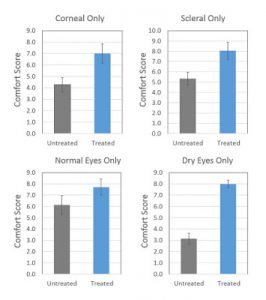New Technology Scores High for Prescription Contact Lens Comfort
By Martyn Lewis
How would it affect all of our businesses if we could reduce the rate of contact lens dropouts due to comfort? There are over 40.9 million contact lens wearers in the USA with promising annual growth trends[1], but there is an annual dropout rate of anywhere between 5 and 60%[2], with the biggest reason often cited as lack of comfort. Indeed in one study by Rumpakis and Crider[2], contact lens dropouts actually exceeded new fits in Europe and Asia, leading to a shrinking of the overall market. What if we could prevent even just a fraction of those dropouts? How much bigger could contact lens wear become?
More than two years of research and development at Contamac are finally bearing fruit, as US FDA approval is now imminent on a revolutionary new coating for the Optimum range of GP contact lenses.
Tangible HydraPEG is a breakthrough polymer coating designed to solve the problem of both silicone hydrogel and GP lens comfort, and at the same time dramatically improve the contact lens experience for both patients and eye care professionals.
By increasing wettability, surface water retention, tear breakup time, lubricity and deposit resistance, Tangible HydraPEG enables contact lens fitters to satisfy patients over the long term and focus on fitting more patients, rather than refitting the same patients.
Having proven the technology in the laboratory, Contamac has engaged in various studies on corneal GPs, scleral GPs, normal eyes and compromised corneas, and we would like to share some of the data from a small study with four investigators in Switzerland, independently led by Michael Bärtschi PhD (Biomedicine), M.Sc.Optom., M.M.E. and Mike Wyss M.Sc., Contact Lens Specialist FAAO, SBAO, EAOO.
19 patients (34 eyes) completed the study conducted by Michael Bärtschi and Mike Wyss in November 2015. There were 11 corneal lenses and 23 scleral lenses. 7 eyes were asymptomatic and 27 had a variety of conditions including irregular cornea, keratoconus, keratoplatik PKP and nystagmus. 10 were classified as having dry eye and 2 patients were neophytes.
All the patients were asked to score their existing lenses on a scale from 1 to 10 for overall comfort. They were then given a new pair of lenses in the same material in the same design with a Tangible HydraPEG coating. At the follow-up visit, a minimum of one week later, they were asked the same comfort questions for their new lenses.
We have broken the comfort scores out into the various categories of patients:
As to be expected, those patients who gave their existing lenses the lowest scores (the dry eye patients) felt the greatest benefit from their Tangible HydraPEG coated lenses, with comfort scores climbing from 3.0 to 8.0, but even patients with “normal eyes” scored their coated lenses 2.0 higher.
The data from this study has been replicated in other studies including one conducted on 24 patients (48 eyes) with self-reported contact lens discomfort symptoms, wearing disposable silicone hydrogel lenses, led by Patrick Caroline at Pacific University. In this study, end-of-day comfort scores for the coated lenses were higher than beginning-of-day comfort scores for uncoated lenses.
There is also an ongoing scleral lens-only study at the University of Houston, with 66% of patients expressing a preference for the Tangible HydraPEG coated lenses and end-of-day comfort scores increasing by between 1.0 and 1.9.
The clinical study for the FDA, being conducted independently in Germany, is being continued past its submission date in order to confirm “real world data” for the durability of the coating. Laboratory testing has shown that the lens still retains a Hydra-PEG coating after 12 months of simulated rubbing, provided that the correct care solutions are used, as approved by Contamac.
If you would like to learn more about installing this exciting new technology for GP and silicone hydrogel contact lenses into your laboratory, please contact Martyn Lewis: martynl@contamac.co.uk
[1] http://www.clspectrum.com/articleviewer.aspx?articleID=113689
[2] https://www.reviewofoptometry.com/article/new-data-on-contact-lens-dropouts-an-international-perspective
